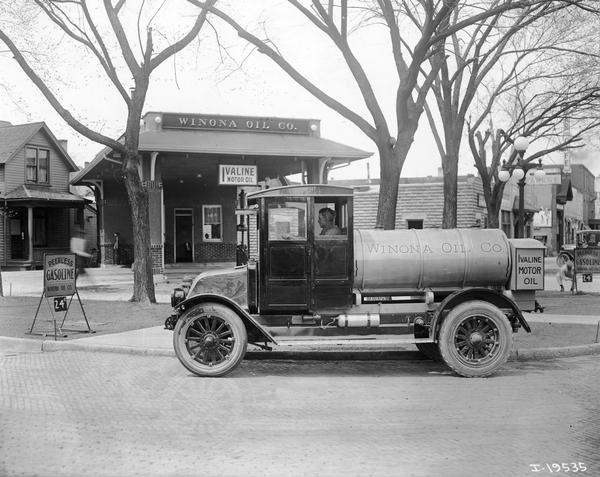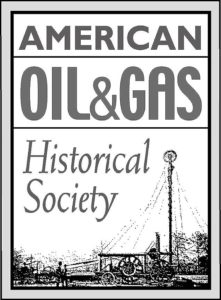Hard lessons learned in the Wyoming Powder River Basin.
During World War I, the Winona Oil Corporation set up operations in Casper, Wyoming, with holdings of 1,200 acres of “selected land in the heart of Powder River.” The small, newly established exploration company reported having one drilling rig and another ready to be “rigged up” at another site.

A Winona Oil Company station sold gasoline and and Ivaline Motor Oil, circa 1919. After months of difficult drilling, the company’s first exploratory well reached a depth of 700 feet without finding oil.
As the Powder River Basin attracted exploration companies, a 1918 discovery at a depth of about 2,600 feet by the Ohio Oil Company (later Marathon) would grow into the largest in the Rocky Mountains. Ohio Oil could afford drilling more productive wells a thousand feet deeper.
Along with earlier discoveries at Salt Creek (1908) and Big Muddy (1916), the Lance Creek field “brought an immediate boom and derricks sprang up everywhere,” according to the Niobrara Historical Society. The Basin’s abundant shale deposits also played a role.
With capitalization of $200,000, Winona Oil was considered a “poor boy” drilling venture dependent upon investors to fund continued drilling despite the risks. The company offered stock at 5 cents a share. Advertisements in the Ogden Standard enticed investors with “Winona Is Here to make Money, Money, Money.”
In February 1918, C. Kirchner, secretary of the Winona Oil, conducted a promotional demonstration of the reduction of shale oil to gas for about 50 onlookers. “This gas was lighted and burned during the entire experiment to such an extent that a couple of engineers in the party made the remark that the gas itself would furnish 90 percent of the fuel necessary for the original reduction,” it was later proclaimed.
This Winona Oil interest in shale oil did not develop, although other contemporary ventures did pursue it (see Ute Oil Company).
Powder River Oilfield
Winona Oil by 1919 had only been able to drill 700 feet in its first drilling effort somewhere “on the north side of the railroad.”

“Hocus Pocus-or-Common Sense?” Ivaline Motor Oil sales did not help the Winona Oil Company to survive its drilling ventures in the highly competitive oilfields of the Powder River Basin.
In March 1919, a trade magazine noted that “the Powder River Syndicate has undertaken to finish the well commenced by the Winona Oil Corporation at Powder River, Natrona Co., according to reports current in Casper.”
Another article in the Oil & Gas News added, “In the Powder River field, the Winona Oil Corporation has announced the purchase of a drilling machine which will be used to complete the company’s first well, which has been underway for months. The Winona claims to have solved all its difficulties and expects to go with its work without further delay.”
By the end of May, Winona Oil Company reportedly survived its financial difficulties and had reentered the field. Plans were by then underway to drill a second well.
Good news came the following month when the first well was described as “gassing heavily, and Casper people interested in the enterprise are very optimistic over the prospects,” the trade publication proclaimed, adding. “Should the well prove a good one, a large tract north of Powder River station would be added to the territory considered proven.”
However, by August the good news had gone bad; the gasser well had to be abandoned, “as the hole was started with a casing too small to see it thoroughly.”
Powder River Syndicate
A second well was spudded by the Powder River Syndicate with Winona Oil a fifty-fifty partner. “The Winona Powder River Syndicate well No. 2, which was begun when the first hole pinched-out, is making 100 feet a day, according to reports from the field, and is down about 500 feet. This well is located north of Powder River, on Winona holdings,” noted the Oil & Gas News on September 4.
The publication reported bad news on January 29, 1920. “The Winona well at Powder River is also shut down, but it is claimed that drilling will resume in the spring,” the News noted. “This is the second well, the first having been lost on account of a bit wedged in the hole.”
Drilling did not resume in the spring or anytime thereafter. Despite the efforts of Winona Oil and the hopes of its investors, the independent exploration company did not survive. Cities Service Company bought Winona Oil and moved the Winona division to St. Paul, Minnesota.
More articles about small exploration and production companies attempting to join petroleum booms (and avoid busts) can be found in Is my Old Oil Stock worth Anything?
______________________
Recommended Reading: Black Gold, Patterns in the Development of Wyoming’s Oil Industry (1997); Trek of the Oil Finders: A History of Exploration for Petroleum (1975). Your Amazon purchase benefits the American Oil & Gas Historical Society. As an Amazon Associate, AOGHS earns a commission from qualifying purchases.
_______________________
The American Oil & Gas Historical Society (AOGHS) preserves U.S. petroleum history. Please become an annual AOGHS supporter and help maintain this energy education website and expand historical research. For more information, contact bawells@aoghs.org. Copyright © 2025 Bruce A. Wells. All rights reserved.
Citation Information – Article Title: “Winona Corporation.” Authors: B.A. Wells and K.L. Wells. Website Name: American Oil & Gas Historical Society. URL: https://aoghs.org/old-oil-stocks/winona-oil-corporation. Last Updated: October 18, 2025. Original Published Date: March 23, 2016.



